Australia/Israel Review
Israel’s first 75 years: 15 Memorable Moments
Mar 31, 2023 | Ahron Shapiro

For Israel’s 75th anniversary, Ahron Shapiro selects 15 singular moments from Israel’s timeline, captured on film, that offer a tiny and incomplete glimpse into the complexity of the endless remarkable story of the little country that could.
1. May 14, 1948 (see above): With the end of the British Mandate, in a ceremony at the Tel Aviv Museum, Head of the Jewish Agency David Ben-Gurion announces the establishment of the State of Israel with a reading of the Declaration of Independence, which states, in part: “The State of Israel will be open for Jewish immigration and for the Ingathering of the Exiles; it will foster the development of the country for the benefit of all its inhabitants; it will be based on freedom, justice and peace as envisaged by the prophets of Israel; it will ensure complete equality of social and political rights to all its inhabitants irrespective of religion, race or sex; it will guarantee freedom of religion, conscience, language, education and culture; it will safeguard the Holy Places of all religions; and it will be faithful to the principles of the Charter of the United Nations.” (Credit: GPO)

2. May 28, 1948: Two weeks after the establishment of Israel, the Jewish Quarter of the Old City of Jerusalem surrenders to the Jordanian Arab Legion. During the 19 years of Jordanian occupation that followed, historic buildings and synagogues in the Jewish Quarter were razed and left in ruins, including the historic Hurva Synagogue, shown here. The armistice agreement between Israel and Jordan, signed at Rhodes on April 3, 1949, stated that a special committee would be formed to allow Israelis “free access to the Holy Places and cultural institutions and use of the cemetery on the Mount of Olives.” In practice, this provision was never implemented, and Jews were forbidden from visiting the Western Wall and other holy sites under Jordanian control. (Credit: Moshe Milner/GPO)
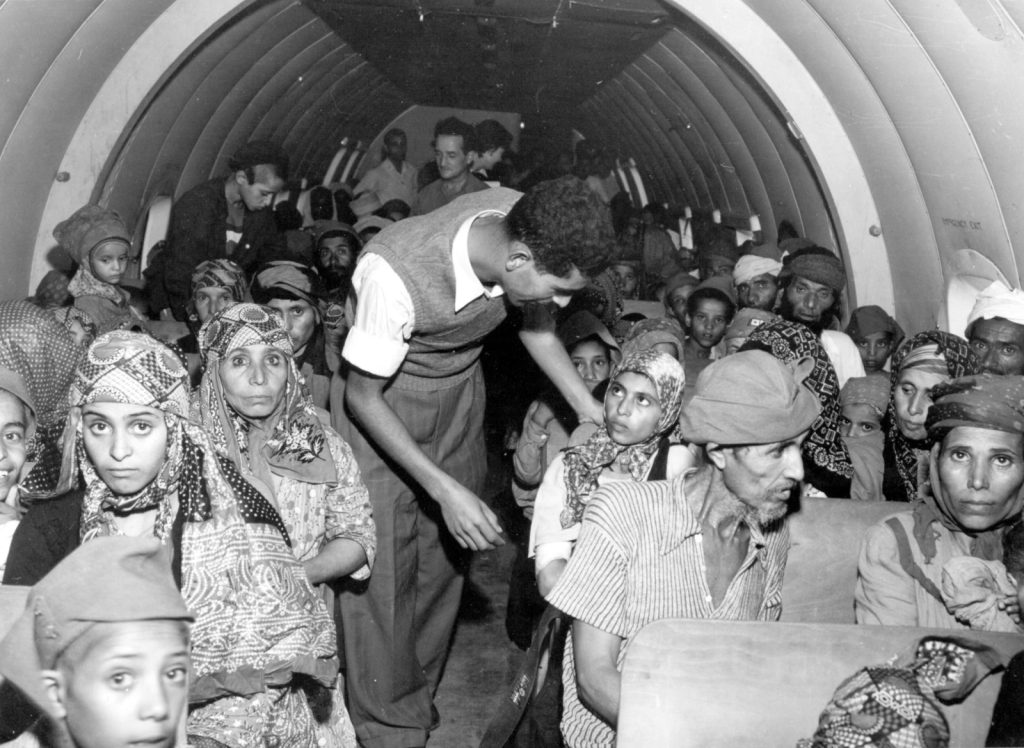 3. 1949: Shalom Havivi, himself a new immigrant to Israel from Yemen, looks after a planeload of Yemenite Jews on their way to resettle in Israel during Operation On Wings of Eagles. Over the years, scenes like this were repeated many times, from many destinations in the Arab world, in operations that were given many different names. According to historian Martin Gilbert’s 2010 book, In Ishamel’s House: A history of Jews in Muslim lands, more than 616,000 Jews were expelled from Arab lands and found refuge in Israel between 1948 and 1972 (some 200,000 Jewish expellees ended up elsewhere). In addition to providing refuge for the Jews from Arab lands, Israel has settled more than 90,000 Ethiopian Israelites, mostly since 1980, and several thousand Jews of northeastern India, known as Bnei Menashe. According to population statistics and recent targeted academic studies, at least half of Israeli Jews today are themselves refugees from Arab lands or their descendants, while a growing number of younger Israelis are of mixed heritage. (Credit: GPO)
3. 1949: Shalom Havivi, himself a new immigrant to Israel from Yemen, looks after a planeload of Yemenite Jews on their way to resettle in Israel during Operation On Wings of Eagles. Over the years, scenes like this were repeated many times, from many destinations in the Arab world, in operations that were given many different names. According to historian Martin Gilbert’s 2010 book, In Ishamel’s House: A history of Jews in Muslim lands, more than 616,000 Jews were expelled from Arab lands and found refuge in Israel between 1948 and 1972 (some 200,000 Jewish expellees ended up elsewhere). In addition to providing refuge for the Jews from Arab lands, Israel has settled more than 90,000 Ethiopian Israelites, mostly since 1980, and several thousand Jews of northeastern India, known as Bnei Menashe. According to population statistics and recent targeted academic studies, at least half of Israeli Jews today are themselves refugees from Arab lands or their descendants, while a growing number of younger Israelis are of mixed heritage. (Credit: GPO)
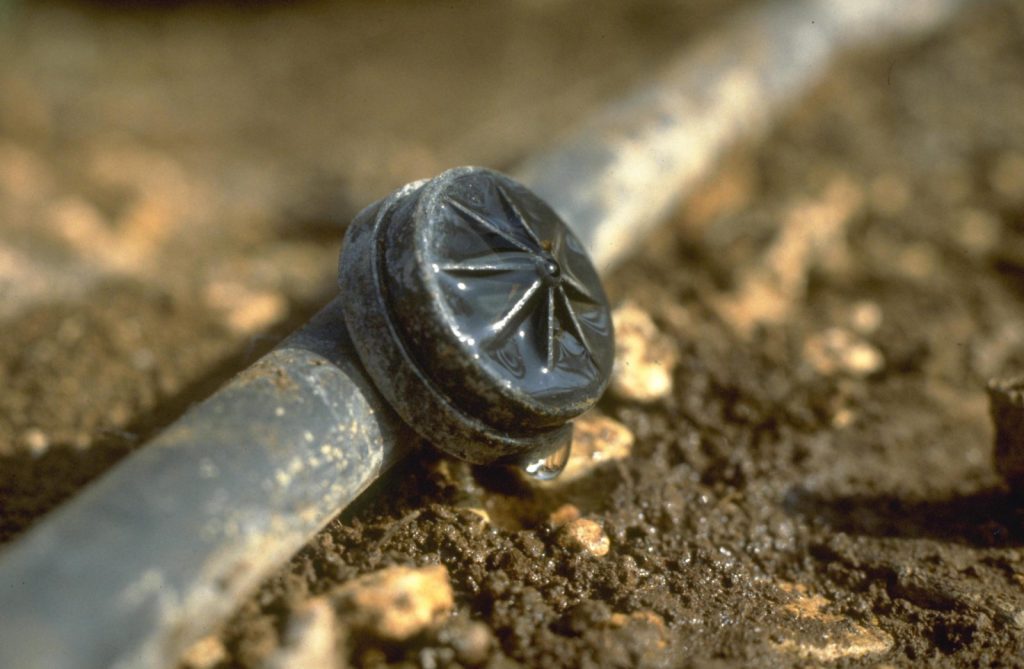
4. 1965: Negev Kibbutz Hatzerim signs a deal with drip irrigation innovator Simcha Blass to develop irrigation systems under the name Netafim, specialising in reducing the amount of water required to hydrate crops, a very crucial need in many of the world’s arid and semi-arid agricultural regions, including most of Australia. In 1966, Netafim marketed the world’s first commercial drip irrigation system. As of 2020, the company continued to hold a 30% share in the world’s drip irrigation market, with revenues of over US$1 billion (A$1.5b), including from Australia. (Credit: Herman Chanania/GPO)
 5. June 9, 1967: Shortly after Israel captured the Old City of Jerusalem from Jordanian forces, an IDF paratrooper and his fiancée are wed at the newly liberated Western Wall, recalling the prophetic words of Jeremiah: “Yet again there shall be heard, in the cities of Judah, and in the streets of Jerusalem, the voice of joy and the voice of gladness, the voice of the bridegroom and the voice of the bride.” Over the following years, the Jewish Quarter of the Old City was rebuilt, restoring whatever historic buildings could be saved and erecting new homes in styles that matched the setting. Meanwhile, the municipality paved the streets of the entire Old City with cobblestones with utilities routed underneath them, thus providing reliable electricity and running water to many residents for the first time. Today, the Jerusalem Municipality remains committed to serving all residents of Jerusalem. In 2023, it opened Wadi Joz Park in east Jerusalem, giving Arab neighbourhoods one of the city’s largest parks. (Credit: GPO)
5. June 9, 1967: Shortly after Israel captured the Old City of Jerusalem from Jordanian forces, an IDF paratrooper and his fiancée are wed at the newly liberated Western Wall, recalling the prophetic words of Jeremiah: “Yet again there shall be heard, in the cities of Judah, and in the streets of Jerusalem, the voice of joy and the voice of gladness, the voice of the bridegroom and the voice of the bride.” Over the following years, the Jewish Quarter of the Old City was rebuilt, restoring whatever historic buildings could be saved and erecting new homes in styles that matched the setting. Meanwhile, the municipality paved the streets of the entire Old City with cobblestones with utilities routed underneath them, thus providing reliable electricity and running water to many residents for the first time. Today, the Jerusalem Municipality remains committed to serving all residents of Jerusalem. In 2023, it opened Wadi Joz Park in east Jerusalem, giving Arab neighbourhoods one of the city’s largest parks. (Credit: GPO)
 6. October 17, 1973: On the 11th day of the Yom Kippur War – the day after an Israeli expeditionary force crossed the Suez Canal – former Chief of Staff Haim Bar-Lev (centre-left) and Defence Minister Moshe Dayan (centre) consult with Maj. Gen. Ariel Sharon (with bandage) somewhere in the Sinai Desert. Israel had been taken by surprise, believing overconfident intelligence evaluations that the risk of Egypt and Syria launching a major war was low. As a result, observation posts on the Golan Heights and the Suez Canal were easily overrun, many Israeli aircraft were shot down by enemy surface-to-air missiles and in the first days of the war, there was a genuine fear at the highest levels that Israel would lose. Only a US resupply airlift and incredible resourcefulness and determination on the battlefield pulled an Israeli victory from the jaws of defeat. Yet, the cost was very high. Israel lost 2,656 soldiers, with more than 7,000 wounded – more than three times the number lost in the Six-Day War. In the aftermath of the war, Prime Minister Golda Meir resigned, confidence in the Labor Alignment Government plummeted, and the stage was set for Likud leader Menachem Begin to lead Israel’s right-wing factions to their first historic victory in 1977. (Credit: Yossi Greenberg/GPO)
6. October 17, 1973: On the 11th day of the Yom Kippur War – the day after an Israeli expeditionary force crossed the Suez Canal – former Chief of Staff Haim Bar-Lev (centre-left) and Defence Minister Moshe Dayan (centre) consult with Maj. Gen. Ariel Sharon (with bandage) somewhere in the Sinai Desert. Israel had been taken by surprise, believing overconfident intelligence evaluations that the risk of Egypt and Syria launching a major war was low. As a result, observation posts on the Golan Heights and the Suez Canal were easily overrun, many Israeli aircraft were shot down by enemy surface-to-air missiles and in the first days of the war, there was a genuine fear at the highest levels that Israel would lose. Only a US resupply airlift and incredible resourcefulness and determination on the battlefield pulled an Israeli victory from the jaws of defeat. Yet, the cost was very high. Israel lost 2,656 soldiers, with more than 7,000 wounded – more than three times the number lost in the Six-Day War. In the aftermath of the war, Prime Minister Golda Meir resigned, confidence in the Labor Alignment Government plummeted, and the stage was set for Likud leader Menachem Begin to lead Israel’s right-wing factions to their first historic victory in 1977. (Credit: Yossi Greenberg/GPO)
 7. July 4, 1976: In what was called Operation Thunderbolt, a team of Israeli counter-terrorist commandos rescued 102 hostages from an Air France plane that had been hijacked by members of the Popular Front for the Liberation of Palestine (PFLP) terror group. The flight, which had originated in Tel Aviv a week earlier, was diverted after a stopover in Athens via Benghazi to Entebbe, the main airport of Uganda. The surprise rescue operation, which required a force of more than 100 fighters as well as multiple air support crews to be transported over 4,000 km and back (with refuelling in Kenya), was considered to be an unqualified success. Sadly however, the commander of the mission, Yoni Netanyahu (older brother of current Prime Minister Binyamin Netanyahu) was killed in the fighting, as were three hostages during the mission. Another who had been ill and been taken to hospital was murdered subsequently. The mission galvanised Israel’s resolve not to capitulate to the demands of terrorists, and added to the IDF’s reputation as perhaps the world’s best counter-terrorism force. In the photograph, hostages and their families share a tearful reunion on the tarmac back in Israel. (Credit: GPO)
7. July 4, 1976: In what was called Operation Thunderbolt, a team of Israeli counter-terrorist commandos rescued 102 hostages from an Air France plane that had been hijacked by members of the Popular Front for the Liberation of Palestine (PFLP) terror group. The flight, which had originated in Tel Aviv a week earlier, was diverted after a stopover in Athens via Benghazi to Entebbe, the main airport of Uganda. The surprise rescue operation, which required a force of more than 100 fighters as well as multiple air support crews to be transported over 4,000 km and back (with refuelling in Kenya), was considered to be an unqualified success. Sadly however, the commander of the mission, Yoni Netanyahu (older brother of current Prime Minister Binyamin Netanyahu) was killed in the fighting, as were three hostages during the mission. Another who had been ill and been taken to hospital was murdered subsequently. The mission galvanised Israel’s resolve not to capitulate to the demands of terrorists, and added to the IDF’s reputation as perhaps the world’s best counter-terrorism force. In the photograph, hostages and their families share a tearful reunion on the tarmac back in Israel. (Credit: GPO)
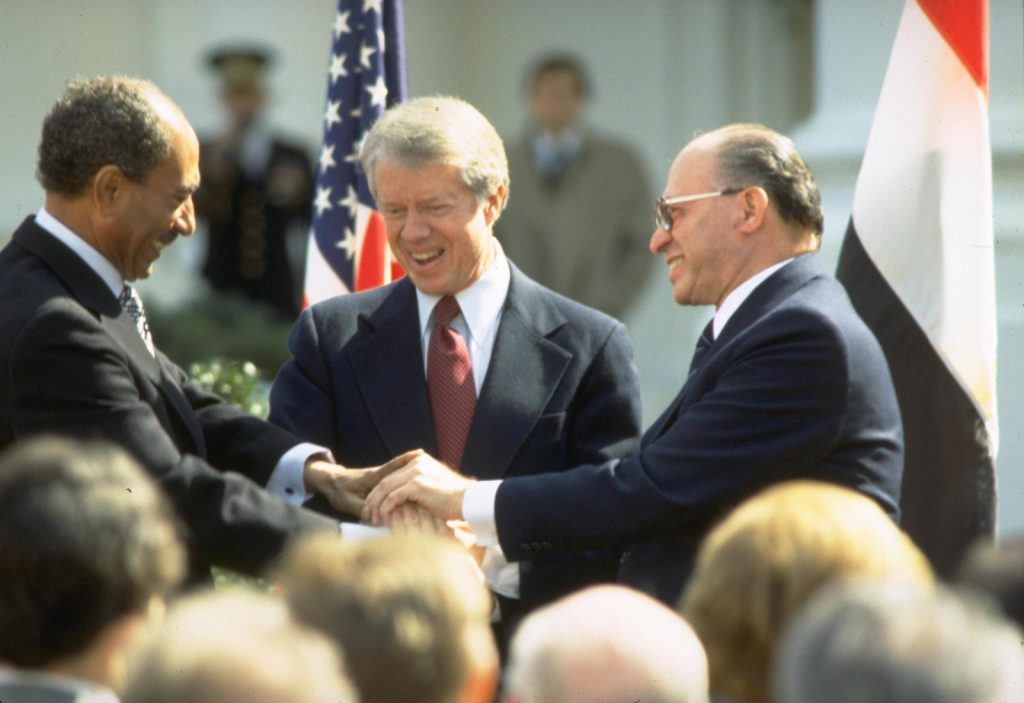 8. March 26, 1979: On this day, at the White House, Israel’s Prime Minister Menachem Begin, US President Jimmy Carter and Egyptian President Anwar Sadat shake hands after the signing of the peace treaty between Israel and Egypt, marking the first formal acceptance of Israel in peace by an Arab country. The agreement, known as the Camp David Accords, had Israel agree to uproot its settlements in the Sinai and return to Cairo the entire peninsula, which it had captured in the 1967 war. For its part, Egypt agreed to demilitarise most of the Sinai and establish full diplomatic relations. In the coming years, passenger flights and bus services would connect the two countries. While the peace has, for the most part, been a cold one lacking grassroots support among the Egyptian people, with relatively little economic cooperation and tourism, Israeli defence officials consider it a crucial gamechanger that practically eliminated the prospect of a massive multi-front war of the kind that Israel faced in 1948, 1967 and 1973. (Credit: Tal Shabtai/GPO)
8. March 26, 1979: On this day, at the White House, Israel’s Prime Minister Menachem Begin, US President Jimmy Carter and Egyptian President Anwar Sadat shake hands after the signing of the peace treaty between Israel and Egypt, marking the first formal acceptance of Israel in peace by an Arab country. The agreement, known as the Camp David Accords, had Israel agree to uproot its settlements in the Sinai and return to Cairo the entire peninsula, which it had captured in the 1967 war. For its part, Egypt agreed to demilitarise most of the Sinai and establish full diplomatic relations. In the coming years, passenger flights and bus services would connect the two countries. While the peace has, for the most part, been a cold one lacking grassroots support among the Egyptian people, with relatively little economic cooperation and tourism, Israeli defence officials consider it a crucial gamechanger that practically eliminated the prospect of a massive multi-front war of the kind that Israel faced in 1948, 1967 and 1973. (Credit: Tal Shabtai/GPO)
 9. June 7, 1981: The Israeli Air Force is deployed to attack Iraq’s Osirak nuclear reactor, which was under construction near Baghdad, and put a stop to Iraq’s illicit nuclear weapons program. It was previously determined that fully loaded planes with additional external fuel tanks could just barely manage the 3,200 km return trip without requiring in-air refuelling – which had seemed all but impossible. The attack squadron consisted of eight recently acquired F-16As, each with two unguided Mark-84 2,000-pound (910 kg) delay-action bombs. The attack established the Begin Doctrine – Israel’s preventive counter-proliferation policy regarding its potential enemies’ capability to possess weapons of mass destruction – a policy that remains relevant today. The plane shown here was flown on the mission by Ilan Ramon, who later became Israel’s first astronaut, on the US Space Shuttle Columbia, a mission which ended tragically when Columbia disintegrated on re-entry into the atmosphere on Feb. 1, 2003. (Credit: KGyST/Wikipedia)
9. June 7, 1981: The Israeli Air Force is deployed to attack Iraq’s Osirak nuclear reactor, which was under construction near Baghdad, and put a stop to Iraq’s illicit nuclear weapons program. It was previously determined that fully loaded planes with additional external fuel tanks could just barely manage the 3,200 km return trip without requiring in-air refuelling – which had seemed all but impossible. The attack squadron consisted of eight recently acquired F-16As, each with two unguided Mark-84 2,000-pound (910 kg) delay-action bombs. The attack established the Begin Doctrine – Israel’s preventive counter-proliferation policy regarding its potential enemies’ capability to possess weapons of mass destruction – a policy that remains relevant today. The plane shown here was flown on the mission by Ilan Ramon, who later became Israel’s first astronaut, on the US Space Shuttle Columbia, a mission which ended tragically when Columbia disintegrated on re-entry into the atmosphere on Feb. 1, 2003. (Credit: KGyST/Wikipedia)
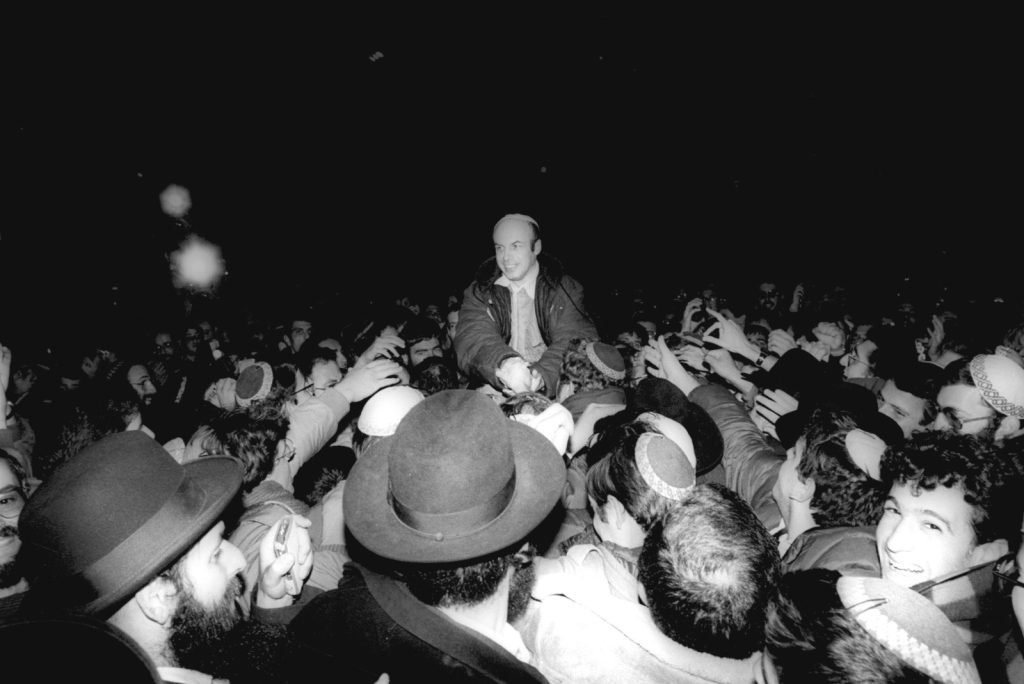 10. February 12, 1986: Soviet refusenik Natan Sharansky, imprisoned for over 13 years due to his request to emigrate to Israel, celebrates his newfound freedom at Jerusalem’s Western Wall the night he arrives in Israel. Earlier, at Ben-Gurion Airport, Sharansky told the crowd that came to welcome him: “Even while in solitary confinement I sang this song ‘How good it is to sit together, brothers together.’”
10. February 12, 1986: Soviet refusenik Natan Sharansky, imprisoned for over 13 years due to his request to emigrate to Israel, celebrates his newfound freedom at Jerusalem’s Western Wall the night he arrives in Israel. Earlier, at Ben-Gurion Airport, Sharansky told the crowd that came to welcome him: “Even while in solitary confinement I sang this song ‘How good it is to sit together, brothers together.’”
Sharansky was freed in a prisoner exchange and most refuseniks were forced to wait several more years for their opportunity to move to Israel, but by the year 1990, the floodgates opened. In that year almost 200,000 Jews from the disintegrating Soviet Union would make Aliyah. Today, more than a million immigrants from the former Soviet Union and their offspring have played a major role in Israel’s modern-day story as the “Start-Up Nation”. (Credit: Eli Sharir/IPPA/Dan Hadani collection, National Library of Israel)
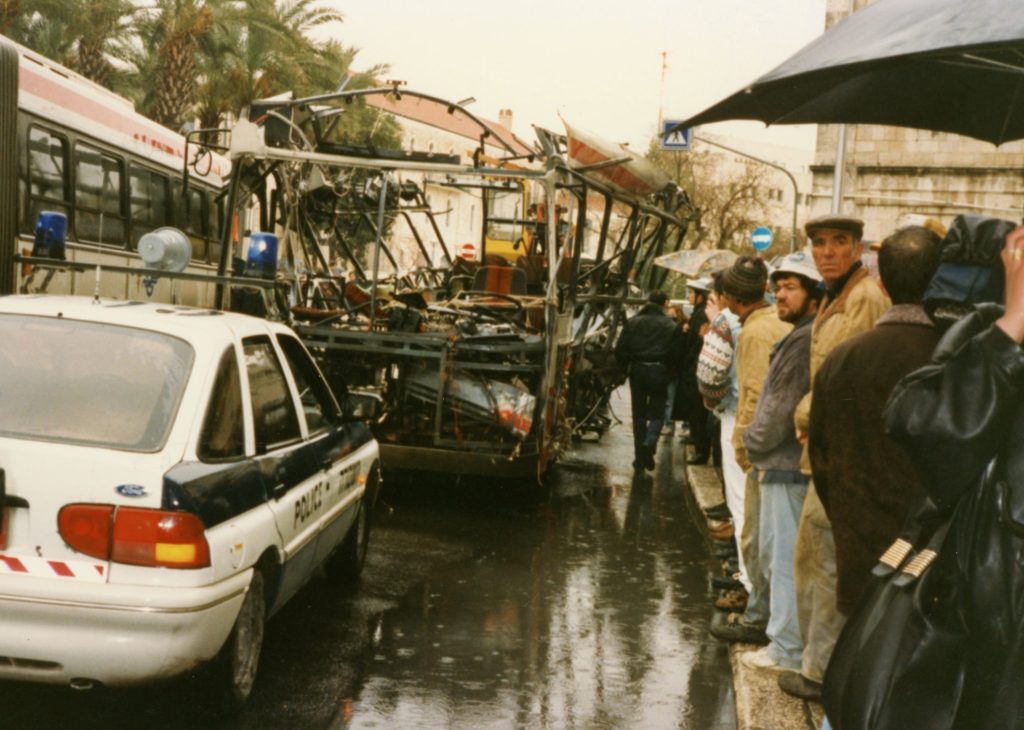 11. March 3, 1996: For the second Sunday morning in a row, Jerusalem’s No. 18 bus is targeted along the city’s downtown thoroughfare, Jaffa Road, by a suicide bomber from the Hamas terror organisation, killing 19 people and wounding seven. In the aftermath, a small crowd of onlookers gather and stare at the crumpled frame of the bus. In the seven-year period between the 1993 Oslo Accords and the outbreak of the Second Intifada, nearly 300 Israelis were killed in terror attacks. (Credit: Ahron Shapiro)
11. March 3, 1996: For the second Sunday morning in a row, Jerusalem’s No. 18 bus is targeted along the city’s downtown thoroughfare, Jaffa Road, by a suicide bomber from the Hamas terror organisation, killing 19 people and wounding seven. In the aftermath, a small crowd of onlookers gather and stare at the crumpled frame of the bus. In the seven-year period between the 1993 Oslo Accords and the outbreak of the Second Intifada, nearly 300 Israelis were killed in terror attacks. (Credit: Ahron Shapiro)
 12. August 9, 2001: At the Jerusalem downtown crossroad of Jaffa Road and King George Street, a Palestinian suicide bomber detonates his explosives inside the Sbarro pizzeria, killing 15 people, including 15-year-old Australian-Israeli student Malka Chana (Malki) Roth. Roth’s parents, Arnold and Frimet, established in her honour Keren Malki, a foundation that provides families of children with severe disabilities in Israel with the means to care for their children at home. During the Second Intifada, which lasted from September 2000 until December 2005, 1,100 Israelis were killed in terror attacks, prompting Israel to build a physical separation barrier between the West Bank and Israel to make it harder for terrorists to infiltrate the country. (Credit: Avi Ohayun/GPO)
12. August 9, 2001: At the Jerusalem downtown crossroad of Jaffa Road and King George Street, a Palestinian suicide bomber detonates his explosives inside the Sbarro pizzeria, killing 15 people, including 15-year-old Australian-Israeli student Malka Chana (Malki) Roth. Roth’s parents, Arnold and Frimet, established in her honour Keren Malki, a foundation that provides families of children with severe disabilities in Israel with the means to care for their children at home. During the Second Intifada, which lasted from September 2000 until December 2005, 1,100 Israelis were killed in terror attacks, prompting Israel to build a physical separation barrier between the West Bank and Israel to make it harder for terrorists to infiltrate the country. (Credit: Avi Ohayun/GPO)
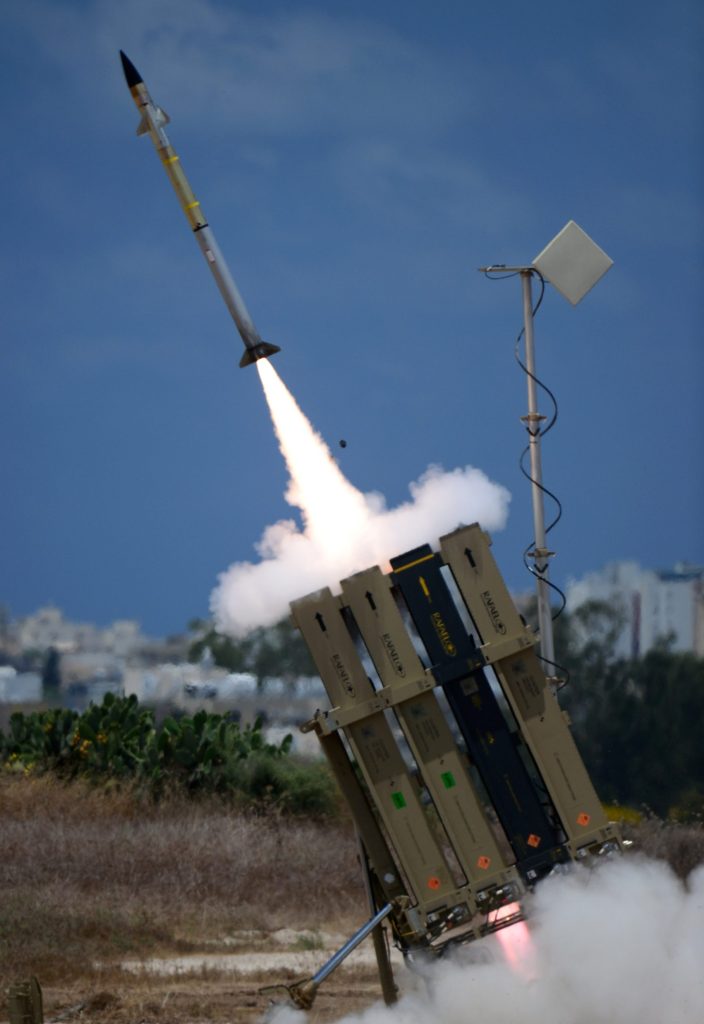 13. April 7, 2011: For the first time, Israel activates its new Iron Dome anti-rocket defence system against Hamas rockets from Gaza. The incredible technology, which had been described by its creators as “stopping a bullet with another bullet,” was pioneered by Rafael Advanced Defence Systems and Israel Aerospace Industries. According to the military requirements specified, what was needed was a system that could continuously scan all of Gaza, detect a rocket the instant it was fired, determine within seconds if it was going to hit a populated area and, if so, knock it out of the sky with its own missile. The project went from a theoretical idea to field tests within four years. While not 100% effective, Iron Dome has greatly weakened the ability of Hamas and Hezbollah to terrorise Israeli communities and has avoided loss of life that in the past might have led to costly escalations and wars. Today, Israel is field testing a system to complement Iron Dome and destroy incoming rockets with a simple but ultra-powerful laser beam – one of several Israel-developed and produced interception technologies that together form perhaps the world’s most sophisticated multi-layered anti-projectile defence system. (Credit: Kobi Gideon/GPO)
13. April 7, 2011: For the first time, Israel activates its new Iron Dome anti-rocket defence system against Hamas rockets from Gaza. The incredible technology, which had been described by its creators as “stopping a bullet with another bullet,” was pioneered by Rafael Advanced Defence Systems and Israel Aerospace Industries. According to the military requirements specified, what was needed was a system that could continuously scan all of Gaza, detect a rocket the instant it was fired, determine within seconds if it was going to hit a populated area and, if so, knock it out of the sky with its own missile. The project went from a theoretical idea to field tests within four years. While not 100% effective, Iron Dome has greatly weakened the ability of Hamas and Hezbollah to terrorise Israeli communities and has avoided loss of life that in the past might have led to costly escalations and wars. Today, Israel is field testing a system to complement Iron Dome and destroy incoming rockets with a simple but ultra-powerful laser beam – one of several Israel-developed and produced interception technologies that together form perhaps the world’s most sophisticated multi-layered anti-projectile defence system. (Credit: Kobi Gideon/GPO)
 14. February 10, 2016: Then-US Ambassador Dan Shapiro takes a ride in a self-driving car equipped with Israeli start-up Mobileye’s road-sensing technology. On March 13, 2017, the tech giant Intel bought Mobileye for US$15.2 billion in a sale that marked the biggest acquisition of any Israeli tech company in history. (Credit: US Embassy, Jerusalem)
14. February 10, 2016: Then-US Ambassador Dan Shapiro takes a ride in a self-driving car equipped with Israeli start-up Mobileye’s road-sensing technology. On March 13, 2017, the tech giant Intel bought Mobileye for US$15.2 billion in a sale that marked the biggest acquisition of any Israeli tech company in history. (Credit: US Embassy, Jerusalem)
 15. September 15, 2020: With the assistance of the United States, Israel signs the historic Abraham Accords with Bahrain and the United Arab Emirates on the South Lawn of the White House. Building on the success of peace agreements of the past, the normalisation agreements in the Abraham Accords are aimed at facilitating Israel’s integration and acceptance in the region – a warming of person-to-person ties and economic and security collaboration. They heralded a move away from a mindset of conflict management to a bright future of development and innovation in an era when the world will be moving away from fossil fuels and into a green-powered tomorrow. From left, Minister of Foreign Affairs of Bahrain Dr. Abdullatif bin Rashid Al-Zayani, Israeli Prime Minister Binyamin Netanyahu, US President Donald Trump, Minister of Foreign Affairs for the United Arab Emirates Abdullah bin Zayed Al Nahyani. (Credit: White House/Shealah Craighead)
15. September 15, 2020: With the assistance of the United States, Israel signs the historic Abraham Accords with Bahrain and the United Arab Emirates on the South Lawn of the White House. Building on the success of peace agreements of the past, the normalisation agreements in the Abraham Accords are aimed at facilitating Israel’s integration and acceptance in the region – a warming of person-to-person ties and economic and security collaboration. They heralded a move away from a mindset of conflict management to a bright future of development and innovation in an era when the world will be moving away from fossil fuels and into a green-powered tomorrow. From left, Minister of Foreign Affairs of Bahrain Dr. Abdullatif bin Rashid Al-Zayani, Israeli Prime Minister Binyamin Netanyahu, US President Donald Trump, Minister of Foreign Affairs for the United Arab Emirates Abdullah bin Zayed Al Nahyani. (Credit: White House/Shealah Craighead)
Tags: Israel, Middle East, Palestinians






